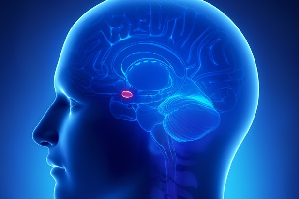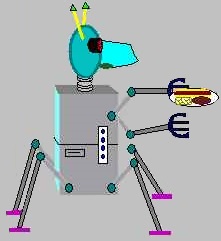27 Mar Cognition and Emotion
 I’m conflicted. I suspect you are too. “Since the time of the ancient Greeks, humans have found it compelling to segregate reason from passion, thinking from feeling, cognition from emotion. These contrasting aspects… have in fact often been viewed as waging an inner battle for control of the human psyche” (LeDoux, 1996, p. 24). In earlier posts, we have looked at the brain physiology specialized in processing emotions. in Emotion – The Perturbable Mr. Amygdala we looked at how the amygdaloid nuclear complex is involved with emotion, posture, sensory integration, endocrine functions and memory. In Emotional Intelligence I asked if machines need to model emotions to exhibit sentient behavior. Is it possible that emotions are required for basic sound logic?
I’m conflicted. I suspect you are too. “Since the time of the ancient Greeks, humans have found it compelling to segregate reason from passion, thinking from feeling, cognition from emotion. These contrasting aspects… have in fact often been viewed as waging an inner battle for control of the human psyche” (LeDoux, 1996, p. 24). In earlier posts, we have looked at the brain physiology specialized in processing emotions. in Emotion – The Perturbable Mr. Amygdala we looked at how the amygdaloid nuclear complex is involved with emotion, posture, sensory integration, endocrine functions and memory. In Emotional Intelligence I asked if machines need to model emotions to exhibit sentient behavior. Is it possible that emotions are required for basic sound logic?
Whatever factors we add to the equation of cognition, including emotional factors, are modelled in computers as constraints. Adding constraints to a process makes it more complex, but often delivers a more suitable outcome. If one of our criteria for developing the model is to make it more like the human brain, or neuromorphic, then we should not ignore our emotions. Beyond emotions, we can also consider pathologies, which may be brought on by imbalances of the very things that keep us functioning normally.
| Understanding Context Cross-Reference |
|---|
| Click on these Links to other posts and glossary/bibliography references |
|
|
|
| Prior Post | Next Post |
| Generalization and Inference | Is Everything Black or White |
| Definitions | References |
| emotion amygdala | LeDoux 1996 |
| integration memory | Erdelyi 1996 |
| subjective algorithm | Pansky 1988 |
Learning to Reason
 To choose the road less traveled, Robert Frost had to stop and think about it. With the continual flood of information that confronts us, we must learn to sort the important from the unimportant. To make decisions, we must often select the better of two or more options. It is probable that emotional feedback enabled Frost, for instance, to learn and retrieve the value information needed to make his decision about which road to travel.
To choose the road less traveled, Robert Frost had to stop and think about it. With the continual flood of information that confronts us, we must learn to sort the important from the unimportant. To make decisions, we must often select the better of two or more options. It is probable that emotional feedback enabled Frost, for instance, to learn and retrieve the value information needed to make his decision about which road to travel.
If we were all like Mr. Spock is depicted in Star Trek, we would use some kind of algorithm in which we would apply numeric values to each of the options based on the quality of the outcome. Whichever option came out with the highest number would win. Many things are so subjective, however, that a purely objective model does not work for all situations. Instead, we have to rely on gut responses, or emotions, to make value judgments on different options and final decisions on what to do.
Developing the skills necessary to make sound decisions involves using many areas of the brain: our perceptual centers for interpreting the input, our correlation centers for making abstract associations with information in memory, and our emotional centers for making value judgements on the relative merits of the various options. For humans, cognition and emotion are inextricably bound together. As we consider the importance of subtext and exformation in language understanding, we’ll see that the number of constraints that affect language understanding is large, and the emotional element may be necessary for efficiency in complex processing tasks.
Dieting?
According to Dr. Michelle May, the TFAR cycle illustrates interesting interplay between thinking and feeling: “It’s essential to realize that what you think causes you to feel a certain way. That in turn causes you to do certain things that ultimately lead to specific results. It’s a chain reaction we call TFAR: Your Thoughts lead to your Feelings, which lead to your Actions, which lead to your Results. Your results reinforce your initial thoughts so they become self-fulfilling prophecies. After proving yourself right over and over again, your thoughts become beliefs. Beliefs then become automatic thoughts that drive your behaviors. In other words, habits.”
Language Learning
Learning language, and virtually all other knowledge acquisition processes may also rely heavily on emotional input. Do you remember Yorrick? The profound impact of the earliest experiences of his life may be the basis of all his knowledge. If this is the case, then emotions are near the center of all knowledge.
 Do you remember the amygdala and its emotional pathways that traverse all areas of the brain? The connection between the hardware and software of cognition appears to be very direct in the case of emotional or gut reactions. Emotional feedback is an important component of cognition because it contributes a fuzzy element to our decision-making skills, without which we would be very brittle thinkers indeed.
Do you remember the amygdala and its emotional pathways that traverse all areas of the brain? The connection between the hardware and software of cognition appears to be very direct in the case of emotional or gut reactions. Emotional feedback is an important component of cognition because it contributes a fuzzy element to our decision-making skills, without which we would be very brittle thinkers indeed.
There is a false dichotomy between thoughts and feelings. They are two species of the same cognitive phenomenon. The distinction has validity in that the seat of emotions in the brain is the amygdala and reasoning is based in the frontal lobe. I call it a false dichotomy because the amygdala is part of the limbic system, which, by the way, is also fundamental to memory and autonomic functions. Memory is critical to rational thought and decision making, and probably has a major role in predicting outcomes based on observed (and stored recollection of) phenomena. This is particularly important in causal reasoning.
The frontal cortex also acts as the seat of personality, perhaps governing how we respond and decide how to act. These decisions vary dramatically in people of all levels of knowledge and intelligence. Consequently, the centers of thought and feeling must interoperate well to deliver rational decisions. Causal phenomena, especially actions based on human decisions, are fundamentally based on thoughts and feelings.
 Bad news! MIPUS just got kicked out. MIPUS’s owners found him to be “emotional and unreliable” when he continued to clear the table before the guests were finished eating. When they asked him to wait, he threw a small automated tantrum and continued to clean up. Now he’s on his own looking for work.
Bad news! MIPUS just got kicked out. MIPUS’s owners found him to be “emotional and unreliable” when he continued to clear the table before the guests were finished eating. When they asked him to wait, he threw a small automated tantrum and continued to clean up. Now he’s on his own looking for work.
As we construct the models for understanding the intent of human language, both “rational” and “emotional” processes will figure prominently.
| Click below to look in each Understanding Context section |
|---|
| Intro | Context | 1 | Brains | 2 | Neurons | 3 | Neural Networks |
| 4 | Perception and Cognition | 5 | Fuzzy Logic | 6 | Language and Dialog | 7 | Cybernetic Models |
| 8 | Apps and Processes | 9 | The End of Code | 10 | Glossary | 11 | Bibliography |








